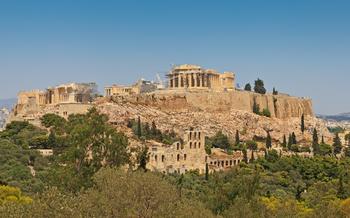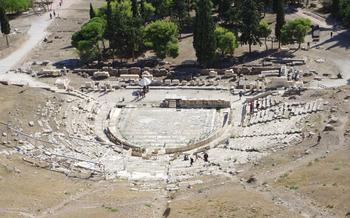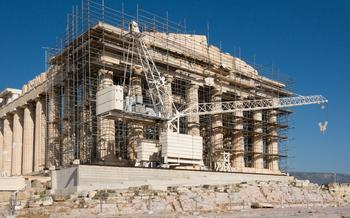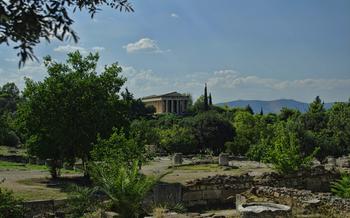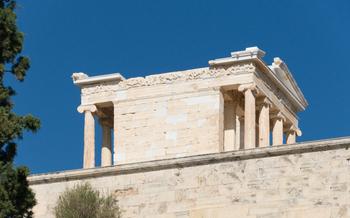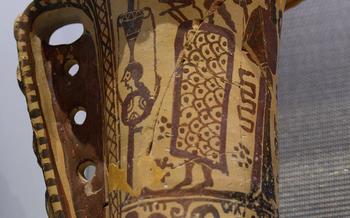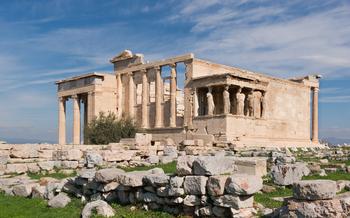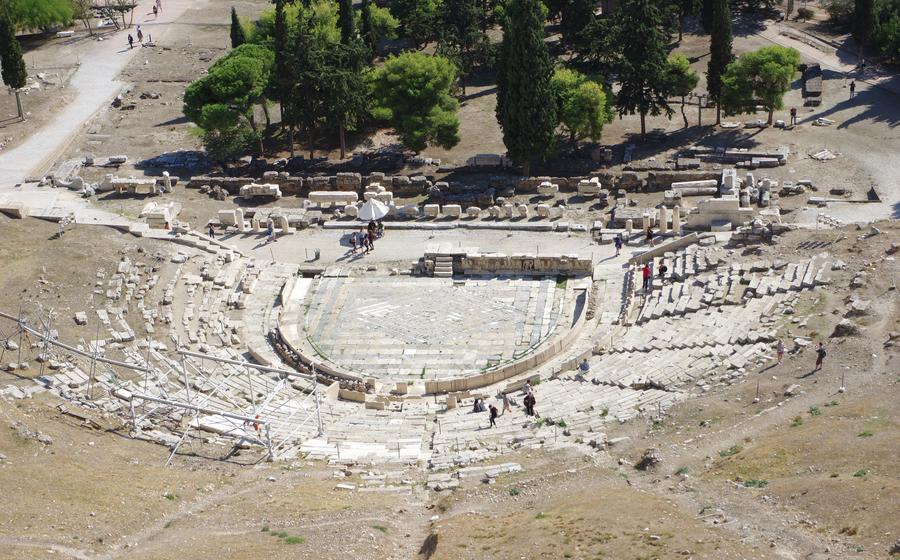
Theatre of Dionysus
- A Journey Through Ancient Drama: Unveiling the Theatre of Dionysus
- Stepping into the Past: A Historical Perspective
- Exploring the Architectural Marvel
- A Stage for Legendary Playwrights
- The Theatre's Role in Athenian Life
- Echoes of Ancient Acoustics
- Preserving the Legacy: Restoration and Conservation
- Finding the Theatre of Dionysus
- Tips for Visiting the Theatre of Dionysus
- A Living History: Performances in the Theatre Today
- Capturing the Essence: Photography and Videography
- Beyond the Theatre: Exploring the Acropolis
- Insider Tip: Unforgettable Sunset Views
A Journey Through Ancient Drama: Unveiling the Theatre of Dionysus
In the heart of ancient Athens, nestled amidst the sacred slopes of the Acropolis, lies the Theatre of Dionysus, a testament to the city's vibrant artistic and cultural heritage. This awe-inspiring theatre, dedicated to the Olympian patron of the arts, Dionysus, stands as a timeless symbol of ancient Greek drama, where legendary playwrights like Aeschylus, Sophocles, Euripides, and Aristophanes showcased their masterpieces. With its rich history, intricate architecture, and captivating performances, the Theatre of Dionysus invites visitors on a journey through the golden age of Athenian theatre, offering a glimpse into the birthplace of Western drama.
Stepping into the Past: A Historical Perspective
The Theatre of Dionysus, steeped in history, traces its origins back to the 6th century BCE. Initially a simple circular dancing ground, it evolved into a grand stone theatre during the 5th century BCE, reflecting the cultural and artistic prowess of ancient Athens. The theatre was dedicated to Dionysus, the god of wine and revelry, whose festivals, known as Dionysia, played a pivotal role in the development of Greek drama.
Religious rituals and performances held in honor of Dionysus laid the foundation for the birth of Greek tragedy and comedy. The theatre served as a sacred space where myths, legends, and societal issues were explored through the medium of drama. Over time, the Theatre of Dionysus became an integral part of Athenian society, hosting not only religious ceremonies but also civic events, political assemblies, and competitions between playwrights.
The theatre's legacy extended far beyond the borders of Greece. Its architectural design, dramatic traditions, and literary masterpieces influenced theatre and performing arts across the ancient world and continue to inspire modern-day theatre productions and performances.
Exploring the Architectural Marvel
The Theatre of Dionysus stands as a testament to ancient Greek ingenuity and artistry. Its seating arrangements, stage design, and acoustic properties were meticulously engineered to create an immersive and awe-inspiring experience for audiences.
The theatre's seating area, known as the koilon, was carved into the natural slope of the Acropolis hill. It could accommodate up to 17,000 spectators, who were arranged in concentric rows according to their social status. The front rows were reserved for dignitaries and priests, while the upper rows were occupied by ordinary citizens.
The stage, or skene, was a raised platform located at the far end of the koilon. It was used by the actors and chorus to perform and interact with the audience. The skene was adorned with elaborate painted backdrops and movable panels, which could be used to create different settings for the plays.
The theatre's acoustics were particularly remarkable. The combination of the sloping seating arrangement and the natural amphitheater-like shape of the hill created a unique acoustic environment. The actors' voices could be heard clearly throughout the entire theatre, even without the use of electronic amplification. This exceptional acoustic quality was achieved through careful consideration of the theatre's dimensions and materials.
Modern-day visitors can still marvel at the architectural ingenuity of the Theatre of Dionysus. Despite the passage of time and the effects of weathering, the theatre's main structural elements remain intact, providing a glimpse into the grandeur and sophistication of ancient Greek theatre.
A Stage for Legendary Playwrights
The Theatre of Dionysus witnessed the birth of some of the greatest plays and playwrights in history. Aeschylus, Sophocles, Euripides, and Aristophanes left an indelible mark on the world of drama, captivating audiences with their powerful stories, poetic language, and philosophical insights.
Aeschylus, often regarded as the father of tragedy, brought a new level of sophistication to the genre with his trilogy of plays based on the Oresteia legend. His works explored themes of justice, revenge, and the consequences of human actions.
Sophocles, another towering figure of Greek tragedy, delved deeply into the human psyche, examining the complexities of the human condition. His plays, such as "Oedipus Rex" and "Antigone," are renowned for their intricate plots, rich character development, and exploration of universal themes.
Euripides, known for his psychological insights and social commentary, challenged conventional norms and explored taboo subjects in his plays. His dramas, such as "Medea" and "The Bacchae," addressed issues of gender, power, and the irrational forces that drive human behavior.
Aristophanes, the master of ancient comedy, used satire and humor to poke fun at Athenian society, politics, and mythology. His plays, such as "The Clouds" and "The Frogs," were both entertaining and thought-provoking, offering a unique perspective on the social and political issues of his time.
The Theatre's Role in Athenian Life
The Theatre of Dionysus served as a central hub for various social, cultural, and political activities in ancient Athens. It was more than just a venue for performances; it was a microcosm of Athenian society.
During religious festivals, the theatre hosted the City Dionysia, a grand celebration honoring the god Dionysus. These festivals featured theatrical competitions, where playwrights showcased their latest works and competed for prestigious awards. The theatre was also a place for social gatherings and entertainment, where Athenians from all walks of life came together to laugh, cry, and be inspired by the performances.
Beyond its cultural significance, the theatre played a vital role in Athenian democracy. It provided a platform for political discourse and debate, where citizens could voice their opinions and engage in discussions about important issues affecting their city-state. The theatre thus became a catalyst for civic engagement and the exchange of ideas, contributing to the development of Athenian democracy.
Moreover, the theatre served as an educational institution, where Athenians gained knowledge about history, mythology, and philosophy. The plays performed in the theatre often explored moral dilemmas, ethical questions, and the human condition, prompting audiences to reflect on their own lives and values. In this way, the Theatre of Dionysus became a melting pot of culture, entertainment, and education, shaping the intellectual and spiritual landscape of ancient Athens.
Echoes of Ancient Acoustics
The Theatre of Dionysus boasts remarkable acoustic properties that allowed ancient audiences to enjoy performances with exceptional clarity. The theatre's unique design and natural setting contribute to this acoustic marvel.
The theatre's amphitheatrical layout, with its concentric rows of seats rising steeply from the orchestra, creates a natural amplifying effect. The curved shape of the seating area focuses sound waves towards the center, ensuring that even those in the back rows could hear the actors clearly.
In addition to the amphitheatrical design, the theatre's location on the southern slope of the Acropolis contributes to its excellent acoustics. The surrounding hills and rock formations act as natural sound reflectors, further enhancing the clarity and projection of sound.
Modern-day experiments have confirmed the theatre's exceptional acoustic properties. Sound engineers have conducted tests using modern audio equipment and found that speech and music can be heard throughout the theatre with remarkable clarity, even without the use of amplification.
This acoustic marvel is a testament to the ingenuity and architectural prowess of the ancient Greeks. Their understanding of acoustics allowed them to create a theatre where every member of the audience could fully experience the power and emotion of live performances.
Preserving the Legacy: Restoration and Conservation
The Theatre of Dionysus stands as a testament to the enduring legacy of ancient Greek theatre. Preserving this iconic structure requires a delicate balance between maintaining its historical integrity and ensuring its longevity for future generations. Over the centuries, the theatre has faced the ravages of time, natural disasters, and human intervention.
The challenges of preserving the Theatre of Dionysus are multifaceted. The theatre's exposed location on the Acropolis makes it vulnerable to the elements, particularly the harsh Athenian sun and rain. The porous limestone used in its construction is prone to erosion, and the theatre's proximity to modern buildings and infrastructure poses additional risks.
To address these challenges, ongoing restoration efforts are meticulously carried out by teams of experts. The focus is on preserving the theatre's original features while employing modern techniques to ensure its structural stability. Restoration efforts include cleaning and repairing the stonework, reinforcing the foundations, and addressing drainage issues to prevent water damage.
Preserving the Theatre of Dionysus is not merely an architectural endeavor; it is a cultural imperative. The theatre represents a tangible connection to the birthplace of Western drama, and its preservation ensures that future generations can continue to experience the magic of ancient performances in an authentic setting.
Finding the Theatre of Dionysus
Nestled within the heart of the Acropolis, the Theatre of Dionysus awaits discovery. To reach this ancient marvel, visitors can embark on a leisurely stroll from the Acropolis metro station, immersing themselves in the historical aura of the surroundings. Alternatively, guided tours provide a wealth of knowledge and insights, enhancing the experience for those seeking a deeper understanding of the site's significance.
The theatre's proximity to other ancient landmarks, such as the Parthenon and the Erechtheion, makes it an ideal starting point for exploring the Acropolis. Visitors can easily navigate through the archaeological park, following designated paths that lead to each site. Along the way, they will encounter remnants of ancient structures, inscriptions, and artifacts that tell the story of Athens' glorious past.
Tips for Visiting the Theatre of Dionysus
To make the most of your visit to the Theatre of Dionysus, here are some valuable tips to keep in mind:
-
Timing is Key: Aim to visit early in the morning or late in the afternoon to avoid the midday heat and crowds.
-
Comfortable Footwear: Wear sturdy and comfortable shoes as the terrain around the theatre can be uneven and slippery.
-
Hydration and Sun Protection: Bring along a bottle of water and wear sunscreen to protect yourself from the sun, especially during the summer months.
-
Combine and Conquer: Take advantage of the proximity of other significant landmarks on the Acropolis. Explore the Parthenon, Erechtheion, and other ancient sites before or after your visit to the Theatre of Dionysus.
-
Embrace the Experience: Allow yourself ample time to wander through the theatre, soak in the atmosphere, and imagine the grandeur of ancient performances. Let the historical significance come alive as you explore this iconic venue.
A Living History: Performances in the Theatre Today
The Theatre of Dionysus, once the stage for ancient masterpieces, continues to breathe life into the past through modern productions of classical plays. These performances, often staged during the summer months, offer a unique opportunity to experience the theatre in its original setting, transporting audiences back in time.
Theatre companies from around the world come to Athens to showcase their interpretations of ancient Greek tragedies and comedies. Actors don the iconic masks and costumes, embodying the characters that graced this stage centuries ago. The atmosphere crackles with energy as the audience becomes part of the performance, immersing themselves in the timeless stories of love, loss, and triumph.
Watching a play at the Theatre of Dionysus is not just a theatrical experience; it is a journey through history. The ancient stone seats, worn smooth by time, bear witness to the laughter and tears of countless spectators who have sat in the same spot, captivated by the performances unfolding before them.
For those seeking an authentic connection with the past, a visit to the Theatre of Dionysus during a live performance is a must. It is a chance to experience the magic of ancient theatre, to feel the pulse of history, and to be transported to a time when the words of Aeschylus, Sophocles, Euripides, and Aristophanes first echoed through these hallowed grounds.
Capturing the Essence: Photography and Videography
When visiting the Theatre of Dionysus, it is natural to want to capture the moment through photography or videography. While doing so, it is important to be mindful of the theatre's historical significance and to respect the rules and guidelines in place.
For photography, tripods and flash photography are generally not allowed within the theatre, as they can be disruptive to other visitors and potentially damage the ancient structure. It is recommended to use a wide-angle lens to capture the theatre's grandeur and to adjust camera settings accordingly to avoid overexposure or underexposure.
For videography, it is important to be aware of the limitations and restrictions imposed by the theatre's management. Filming may be permitted for personal use, but commercial filming or professional photography typically requires prior authorization and permits. It is always advisable to check with the authorities or tour guides to understand the specific regulations.
When capturing the Theatre of Dionysus through photography or videography, it is important to focus on the theatre's unique features and details. The worn stone steps, the intricate carvings, and the surrounding natural landscape all contribute to the theatre's charm and history. By respecting the guidelines and using creativity, visitors can create lasting memories and share the beauty of this ancient wonder with others.
Beyond the Theatre: Exploring the Acropolis
Venturing beyond the Theatre of Dionysus, the Acropolis unveils a treasure trove of ancient wonders. The Parthenon, a majestic temple dedicated to the goddess Athena, stands as a testament to classical architecture. Its Doric columns, intricate sculptures, and harmonious proportions have captivated visitors for centuries. A short walk away, the Erechtheion, with its distinctive Caryatid Porch, pays homage to the mythical rivalry between Athena and Poseidon. This well-preserved temple offers a glimpse into the religious and political significance of the Acropolis.
Strolling through the Acropolis, visitors are immersed in a rich tapestry of history and culture. Every nook and cranny holds a story, from the Propylaea, the grand entrance gate, to the Temple of Athena Nike, perched on a rocky outcrop. The Acropolis was not merely a religious center; it was also a place of political gatherings, philosophical debates, and artistic expression.
Exploring the Acropolis alongside the Theatre of Dionysus provides a comprehensive understanding of ancient Athenian society. By piecing together the fragments of history scattered throughout the site, visitors gain insights into the religious beliefs, artistic achievements, and civic life of this remarkable civilization.
Insider Tip: Unforgettable Sunset Views
As the sun begins its descent, casting a warm golden glow across the ancient stones of the Acropolis, the Theatre of Dionysus transforms into a magical setting. The sky erupts in a vibrant tapestry of colors, painting the horizon with hues of orange, pink, and purple. From the theatre's elevated position, visitors are treated to a breathtaking panorama of the Acropolis and the city of Athens stretching out below.
Watching the sunset from the Theatre of Dionysus is an experience that will linger in your memory long after your visit. As the last rays of sunlight bathe the ancient theatre in a soft golden light, you can almost imagine the ghosts of ancient Athenians filling the seats, eager to witness the latest theatrical masterpiece. It's a moment of pure enchantment, where history, beauty, and nature converge to create a truly unforgettable spectacle.
So, if you're looking for a unique and awe-inspiring way to end your day in Athens, make sure to visit the Theatre of Dionysus at sunset. Whether you're a history buff, a theatre enthusiast, or simply someone who appreciates breathtaking views, this is an experience that you won't want to miss.
